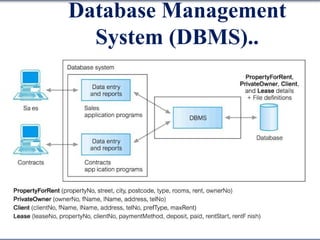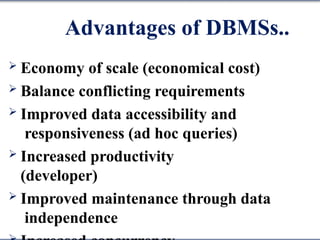introduction to database management system
- 2. Chapter 1 - Objectives Some common uses of database systems Characteristics of file-based systems Problems with file-based approach Meaning of the term database (DB) Meaning of the term Database Management System (DBMS)
- 3. Chapter 1 - Objectives Typical functions of a DBMS. Major components of the DBMS environment. Personnel involved in the DBMS environment. History of the development of DBMSs. Advantages and disadvantages of DBMSs.
- 4. Definition 1 A database is a shared collection of logically related data that is stored to meet the requirements of different users of an organization
- 5. The concept of a shared organizational database Accounting Accounts Payable Accounts Receivable Management Control Planning Manufacturing Production Scheduling Marketing Product Development Sales Corporate Database
- 6. Examples of Database Applications Purchases from the supermarket Purchases using your credit card Booking a holiday at the travel agents Using the local library Taking out insurance Renting a video Using the Internet Studying at university
- 7. File-Based Systems Early attempt to Computerize the manual filing system Collection of application programs that perform services for the end users (e.g. reports). Each program defines and manages its own data.
- 8. Manual Filing Systems Works well while number of items to be stored is small For only storage or retrieval functionality of large number of items
- 9. File-Based Systems Consider DreamHome example for file- based systems Sales Department : responsible for selling and renting of properties Contract Department: responsible for handling lease agreements
- 10. Sales Department PropertyForRent (propertyNo, street, city, postcode, type, rooms, rent, ownerNo) Client (clientNo, fName, lName, telNo, preftype, maxRent) PrivateOwner (ownerNo, fName, lName, address, telNo)
- 11. ownerNo fName lName address telNo CO46 Joe Keogh … 01224-861212 CO87 Carol Farrel … 0141-357-7419 CO40 … … … … CO93 … … … … propertyNo street city postcode type rooms rent ownerNo PA14 … Aberdeen … House 6 650 CO46 PL94 … London … Flat 4 400 CO87 PG4 … Glasgow … Flat 3 350 CO40 PG36 … Glasgow … Flat 3 375 CO93 PG21 … Glasgow … House 5 600 CO87 PG16 … Glasgow … Flat 4 450 CO93 PrivateOwner PropertyForRent
- 12. clientNo fName lName telNo prefType maxRent CR76 John Kay 0207-774-5632 Flat 425 CR56 Aline Stewart 0141-848-1825 Flat 350 CR74 Mike Ritchie 01475-392178 House 750 CR62 Mary Tregear 01224-196720 Flat 600 Client
- 13. Contract Department Lease (leaseNo, propertyNo, clientNo, rent , paymentMethod, deposit, paid, rentStart, rentFinish, duration) PropertyForRent (propertyNo, street, city, postcode, type, rooms, rent) Client (clientNo, fName, lName, telNo, preftype, maxRent)
- 14. Lease leaseNo propertyNo clientNo rent --- rentStart rentFinish duration 10024 PA14 CR62 650 1-Jun-05 31-May-06 12 … … … … … … … … propertyNo street city postcode type rooms rent PA14 … Aberdeen … House 6 650 PL94 … London … Flat 4 400 PG4 … Glasgow … Flat 3 350 PG36 … Glasgow … Flat 3 375 PG21 … Glasgow … House 5 600 PG16 … Glasgow … Flat 4 450 PropertyForRent
- 15. clientNo fName lName telNo CR76 John Kay 0207-774-5632 CR56 Aline Stewart 0141-848-1825 CR74 Mike Ritchie 01475-392178 CR62 Mary Tregear 01224-196720 Client
- 17. Limitations of File-Based Approach Separation and isolation of data Each program maintains its own set of data. Users of one program may be unaware of potentially useful data held by other programs. For example, if we want to produce a list of all houses that match the requirements of the clients. Duplication of data Decentralized approach taken by each department. Same data is held by different programs. Wasted space and potentially different values and/or different formats for the same item.
- 18. Limitations of File-Based Approach.. Data dependence File structure is defined in the program code. Incompatible file formats Programs are written in different languages, and so cannot easily access each other’s files. Fixed Queries/Proliferation of application programs Programs are written to satisfy particular functions. Any new requirement needs a new program.
- 19. Database Shared collection of logically related data, and a description of this data, designed to meet the information needs of an organization. System catalog (metadata) provides description of data to enable program- data independence. Logically related data comprises entities, attributes, and relationships of an organization’s information.
- 20. Database Management System (DBMS) A software system that enables users to define, create, maintain, and control access to the database. (Database) application program: a computer program that interacts with database by issuing an appropriate request (SQL statement) to the DBMS.
- 22. Database Approach Data definition language (DDL). Permits specification of data types, structures and any data constraints. All specifications are stored in the database. Data manipulation language (DML). General enquiry facility (query language) of the data.
- 23. Database Approach.. Controlled access to database may include A security system Which prevents unauthorized users accessing the database An integrity system Which maintains the consistency of stored data A concurrency control system Which allows shared access of the database A recovery control system Which restores the database to a previous consistent state in case of hardware or software failure A user-accessible catalog Which contains description of the data in the database
- 24. View s Allows each user to have his or her own view of the database. A view is essentially some subset of the database.
- 25. Views - Benefits Reduce complexity Provide a level of security Provide a mechanism to customize the appearance of the database Present a consistent, unchanging picture of the structure of the database, even if the underlying database is changed
- 26. Summary Introduction to DB and DBMS File-based systems and their limitations Database approach
- 28. Components of DBMS Environment.. Hardware Can range from a PC to a network of computers. Software DBMS, operating system, network software (if necessary) and also the application programs. Data Used by the organization and a description of this data called the schema.
- 29. Components of DBMS Environment.. Procedures Instructions and rules that should be applied to the design and use of the database and DBMS. People
- 30. Roles in the Database Environment Data Administrator (DA) Database planning Development and maintenance of standards, policies and procedures Database Administrator (DBA) Physical realization of the database Physical database design and implementation Security and integrity control Maintenance of the operational system Ensuring satisfactory performance of the applications for users Database Designers (Logical and Physical) Application Programmers End Users (naive and sophisticated)
- 31. History of Database Systems Roots of the DBMS Apollo moon-landing project, 1960s NAA (North American Aviation), prime contractor for the project Developed a software GUAM (Generalized Update Access Method), hierarchical In mid – 1960s IBM joined NAA, result was IMS(Information Management System)
- 32. History of Database Systems.. IDS ( Integrated Data Store) By General Electric, network, mid-1960 CODASYL ( Conference on Data Systems Languages) DBTG (Data Base Task Group)
- 33. History of Database Systems.. DBTG proposal in 1971, components The network schema: the logical organization of the entire database as seen by the DBA – which includes a definition of the database name, the type of each record, and the components of each record type. The subschema: the part of the database as seen by the user or application program; A data management language to define the data characteristics and the data structure, and to manipulate the data.
- 34. History of Database Systems.. DBTG specified three languages A schema Data Definition Language (DDL), which enables the DBA to define the schema. A subschema DDL, which allows the application programs to define the parts of the database they require. A Data Manipulation Language (DML), to manipulate the data.
- 35. History of Database Systems.. E. F. Codd, 1970 IBM Research Laboratory Relational model System R project by IBM’S San Jose Research Laboratory California Result of this project Development of SQL Commercial relational DBMS products e.g. DB2, SQL/DS from IBM, Oracle from Oracle Corp.
- 36. DBMS Generations First-generation Hierarchical and Network Second generation Relational Third generation Object-Relational Object-Oriented
- 37. Advantages of DBMSs Control of data redundancy Data consistency More information from the same amount of data Sharing of data Improved data integrity (constraints) Improved security (authentication, rights) Enforcement of standards (data formats, naming conventions, documentation
- 38. Advantages of DBMSs.. Economy of scale (economical cost) Balance conflicting requirements Improved data accessibility and responsiveness (ad hoc queries) Increased productivity (developer) Improved maintenance through data independence
- 39. Advantages of DBMSs.. Improved backup and recovery services
- 40. Disadvantages of DBMSs Complexity Size (disk space for DBMS) Cost of DBMS Additional hardware costs Cost of conversion Performance Higher impact of a failure
- 41. Summary Introduction to DB and DBMS File-based systems and their limitations Database approach Components of the DBMS environment Roles in the DB environment History of DBMS Advantages/Disadvantages of DBMSs








































